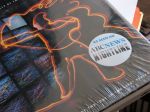This is not the first blog I’ve abandoned. That would be Words at http://www.markeveretthall.com, an experiment I conducted many years ago. I created Words to post some of my old published essays and to play with Apple’s iWeb software, the worst blogging tool I’ve worked with by far. I learned what I could and then, like so many other people, moved on to other things.
In addition to Words and now this, I’ve also dropped two other blogs. One, Sanity as a Service, was for Computerworld and the other ran at TG Daily. Both companies were paying me enough to post regularly, then they changed the deals, so I stopped writing for them.
From the start, Croisan Views was a different kettle of fish. I began it less than eleven months ago with a specific goal: quit after 100 posts or one year, whichever comes first. This is my 100th post.
Millions of individuals have started blogs, then tossed them away for various reasons. Gartner Inc., the market research firm, estimated that as many as 200 million blogs may have been left to rot on the side of the Information Superhighway. As you know, that doesn’t mean there’s a blog famine ahead. WordPress, which hosts Croisan Views (and is the best tool I’ve used to manage a blog), alone has 18 million blogs. Blogger, LiveJournal, Xanga, and other sites offer millions upon millions more.
Some bloggers approach their task as if it were a never-ending story, infinite in scope, not unlike the Internet itself. That’s why so many blogs get abandoned by their authors. The work becomes too daunting after the initial rush of good feeling upon seeing their work online. That feeling can give way to despair once the deathly silence of the worldwide web envelops the blog.
Most successful blogs are tightly focused. Whether on technology, politics, baseball, or whatever, they reflect the passions and obsessions of their creators. But I wanted Croisan Views to reflect my overall life during the time I wrote it; a general-interest blog that detailed things that I did as well as the world as I saw it. Yet, I thought the blog should be more than a public airing of my personal diary, something I’ve kept since the 1970s. Admittedly, this strategy is not a recipe for an overwhelmingly successful blog. But it made it a pleasure to write.
As I’ve noted before, I am a numbers-obsessed fella. In addition to my personal output target of 100 posts, I wanted to generate a modicum of traffic to Croisan Views. I thought 5,000 unique visitors in a year was reasonable. I surpassed that number early last month. Lately, I’ve been averaging about 200 people per week, up from around 50 this past autumn.
Getting people to my site was not easy. I lacked an established third-party source, such as Computerworld, to manufacture attention to the blog. I never paid a dime to any SEO company or expert to develop a plan for adding more visitors. Growth, such as it was, was all organic. From its launch last April, it took nearly two months until Google, Bing, and Yahoo began to index Croisan Views. Search engines drive about half the people to this blog. Twitter, where my @Croisan existed until last month, as well as my Facebook account delivered a small, steady number of folks. But it was Reddit and StumbleUpon, which I just started using in January, that gave me the biggest bumps in unique visitors. Although my old blog editor at Computerworld says it’s the top source for her operations, I never used Digg because I find the service tedious.
Choosing accompanying art, as we print-publishing people call any image associated with a story, was one of the more difficult parts of the blog process. I want it to connect in some way to the specific post, but I was limited in my store of images. Virtually every photograph on the blog was taken by me, although my friend Klaus Herzberger snapped the one of me in the Alps and I’ve used public domain images on a couple occasions. Of course, David Leishman generously provided me with magazine covers from his magnificent collection, which I’ve used from time to time.
Croisan Views has been a joy and a burden. As I noted with my post about quitting microblogging at Twitter, keeping a blog is time consuming. Finding good links, responding to comments, choosing and cropping photos, and simply coming up with new ideas and then writing and editing them all take up hours each week. The volume of work I produced here would fill a small book if printed.
I’m glad Croisan Views is done, though I suspect I’ll miss it. I hope in some small way, you will, too.









Commenting on Comments
5 JulAmong the many blessings the Worldwide Web has brought us is the Comment section following any article published online. From the New York Times to Haaretz from the lowliest blogger to soaring celebrities, readers get to post their reactions to news, events, opinions, and, yes, commentary everywhere. Editors like to label it “community involvement” or some such nonsense.
That’s what most of it is, too, nonsense.
First, the overwhelming majority of the comments left by readers are anonymous. Or, at websites like Salon, each commentator has a made-up user name that guarantees anonymity to other readers. Some print publications even have begun using anonymous messages left online as submissions to the Letters section of their magazines. Wired magazine sprinkles them amidst missives signed by real people. My former employer Computerworld rarely publishes a letter from writer who has an actual name and job title. Every one is signed by Anonymous.
Second, commentators have trouble staying on topic. They stray this way and that. Single-minded folks will always write about their hot-button topic no matter the subject at hand. Often anonymous writers will get into pissing matches with one another, careening off onto unrelated territory with their invective-charged comments.
Third, there’s the invective itself. Being anonymous, many commentators see little reason to grace their words with an iota of politeness. They rant. They rage. They rip everyone apart. From where they sit, it seems, nothing and no one is worth a smidgeon of respect. To them an insult is a worthy insight.
Finally, there’s the plain ignorance on display. As noted earlier in this blog, professional writers need copyeditors. So, I do not hold it against readers when they post comments rife with typos or wrong subject-verb agreements. That’s why in days gone by a Letters page editor might connect with readers who submitted letters to have them approve an edited item. It’s also why other magazines would proclaim on a Letters page that submissions might be subject to editing for “length and clarity.” But, in so many cases, even a good editor could not make sense of some of the reader responses left online.
All this is not to say I abhor reader reactions to stories and OpEd pieces. Obviously, I read them. But sometimes at the end of a session reading a long string of pointless, mean-spirited, logic-free, and downright dumb comments, I feel as though I have utterly wasted my time. That the only reason I kept reading was to come across a prize example of reader foolishness. It’s as if I am a NASCAR fan, claiming to be enthralled by the roaring cars hurtling past in a blur, when all I am really waiting for is for the cars to crash.
Tags: anonymity, anonymous letters, reader comments